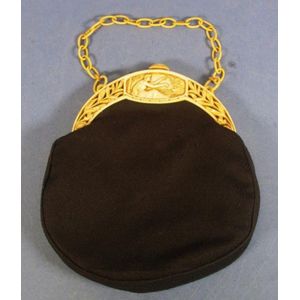Lady & Bird Art Deco Celluloid Evening Bag
You must be a subscriber, and be logged in to view price and dealer details.
Subscribe Now to view actual auction price for this item
When you subscribe, you have the option of setting the currency in which to display prices to $Au, $US, $NZ or Stg.
- Celluloid - In 1864 an American scientist by the name of Parkes mixed camphor with nitrocellulose, etc. The result was what came to be known as "celluloid", the first form of plastic, and a product for which Parkes could find no use.
Some time later when the supplies of ivory for making billiard balls were becoming difficult to obtain, an inventor produced a perfect billiard ball from a mould using "celluloid".
Toys, dolls and other products such as combs, cutlery handles and costume jewellery made from celluloid began appearing on the market from 1913 and continued to do so until the early 1950s by which time it was superseded by more modern products due to safety concerns because it was highly flammable and brittle product. - Art Deco Period - The Art Deco period was a cultural movement that emerged in the 1920s and 1930s, and was characterized by its emphasis on modernism, luxury, and elegance. The name "Art Deco" comes from the Exposition Internationale des Arts Décoratifs et Industriels Modernes, a large exhibition held in Paris in 1925 that showcased the latest trends in decorative arts.
Art Deco was a reaction against the ornate and elaborate styles of the previous era, and reflected a new modern sensibility. It was characterized by streamlined, geometric shapes, bright colours, and the use of new materials such as chrome, glass, and Bakelite. Art Deco designers sought to create a sense of luxury and sophistication, often incorporating expensive materials such as ivory, marble, and rare woods.
Art Deco had a significant impact on a wide range of artistic fields, including architecture, fashion, graphic design, and interior design. Some of the most iconic examples of Art Deco architecture include the Empire State Building in New York City, the Hoover Building in London, and the Palais de Chaillot in Paris.
The Art Deco period came to an end in the 1940s, as World War II and changing cultural trends led to a shift in artistic styles. However, Art Deco remains an important influence on design and art, and continues to be celebrated for its modernist sensibility and glamorous aesthetic.
This item has been included into following indexes:
Visually similar items

Two various Spode creamware shaped serving dishes, Including iron red painted border, painted mark AGC 1311 and design # 1554 to base, and painted brown border, impressed mark to base. Length 27 cm (each). (A.G.C. is for A. Gresham Copeland, most items wit

18ct yellow gold necklace, approx 41.5 grams

9ct yellow gold chain, approx 20.0 grams and 80 cm in length

A 9ct rose gold pendant necklace, round link chain with Faberge-style egg pendant styled as a flowering plant. Length 46 cm. Weight 14.3g.
